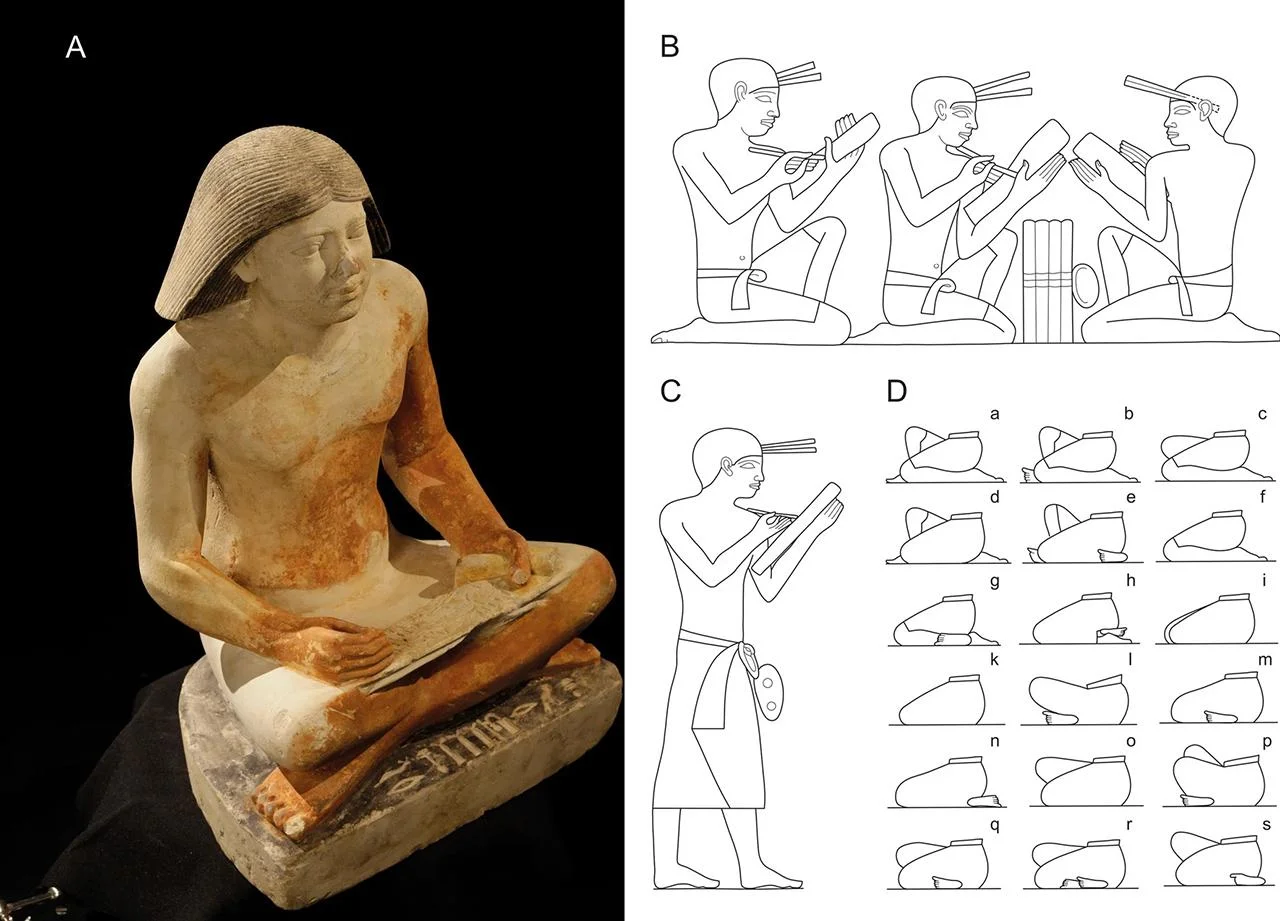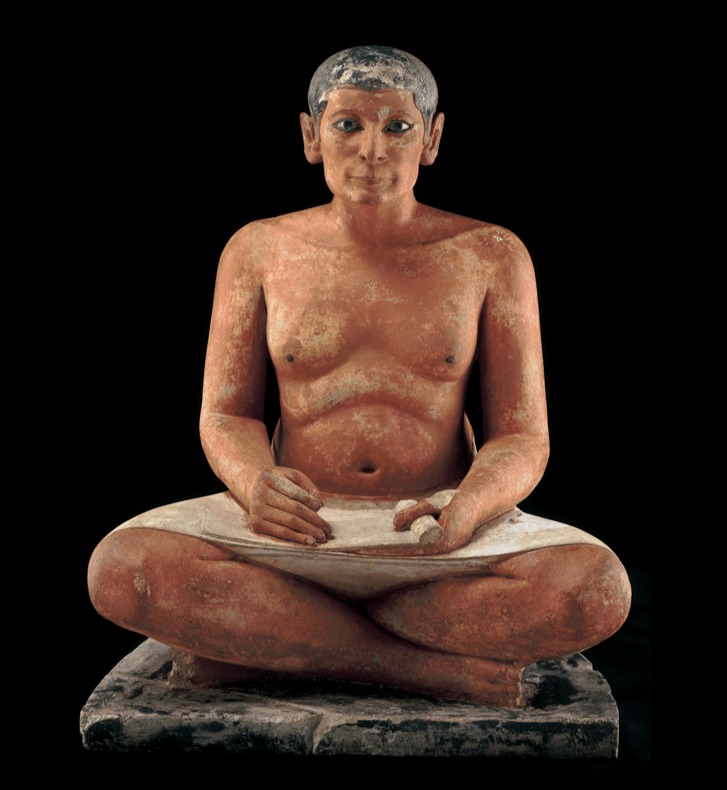In the ancient necropolis of Abusir, located in modern-day Egypt, the skeletal remains of long-deceased scribes have revealed the physical toll their prestigious occupation took on their bodies. Recent research published in the journal Scientific Reports has shed light on the occupational hazards faced by these literate men, whose daily activities and working postures led to significant degenerative changes in their skeletons.
As guardians of the written word and integral cogs in the bureaucratic machinery of the ancient Egyptian state, scribes held a revered status within their society. However, the physical demands of their work, including prolonged periods of cross-legged sitting, repetitive writing tasks, and the use of specialized tools, have left an indelible mark on their skeletal structures.
In this blog post, we’ll delve into the findings of this fascinating study, exploring how the daily lives of ancient Egyptian scribes impacted their physical well-being and providing insights into the often-overlooked realities of life in this renowned civilization.
The Prestigious Position of Scribes in Ancient Egypt
During the Old Kingdom of ancient Egypt, spanning the 3rd to 6th dynasties (c. 2686-2181 BCE), literacy was a rare and highly valued skill, possessed by only around 1% of the population. Scribes, those individuals entrusted with the written word, held a prestigious position within society, serving as vital administrators and bureaucrats responsible for the smooth functioning of the state.

These literate men were responsible for a wide range of tasks, from recording important events and transactions to maintaining detailed records and inventories. Their role was essential in the operation of the ancient Egyptian government, and their status was reflected in the relative comfort and security of their lives compared to the majority of the population.
However, the physical demands of their work were not without consequence, as the recent study of their skeletal remains has revealed.
Uncovering the Occupational Hazards of Scribes
The study, led by anthropologist Petra Brukner Havelková of the National Museum in Prague, examined the skeletal remains of 69 adult males buried in the ancient necropolis of Abusir, dating back to the 3rd millennium BCE. Of these individuals, 30 were identified as scribes based on their burial artifacts and physical characteristics.
The researchers found that the scribes exhibited a significantly higher prevalence of degenerative joint changes compared to their non-scribe counterparts. These changes were most pronounced in the following areas:
- The joints connecting the lower jaw to the skull
- The right collarbone
- The top of the right humerus (upper arm bone)
- The first metacarpal bone in the right thumb
- The bottom of the thigh
- Throughout the spine, especially in the neck
The team suggested that these degenerative changes were likely the result of the prolonged cross-legged sitting position commonly adopted by scribes, with their heads bent forward, spines flexed, and arms unsupported. Additional changes in the knees, hips, and ankles indicated that scribes might have also sat in a kneeling or squatting position, with one leg bent upwards.
The Physical Toll of Scribal Tasks
The physical stress experienced by ancient Egyptian scribes was not limited to their working postures; it was also evident in the specific tasks they performed on a daily basis.

Archaeological evidence, such as statues, wall reliefs, and historical texts, has provided valuable insights into the tools and techniques used by these literate men. Scribes typically used a thin rush pen for writing on papyrus, wooden boards, and ostraca (fragments of pottery or limestone used as writing surfaces).
The researchers found that the degeneration in the scribes’ jaw joints was likely caused by their habit of chewing the ends of the rush stems to form brush-like heads, which were then used for writing. Additionally, the signs of degeneration in their right thumbs were attributed to the repetitive pinching motion required to hold and manipulate the pens.
“Our research reveals that remaining in a cross-legged sitting or kneeling position for extended periods, and the repetitive tasks related to writing and the adjusting of the rush pens during scribal activity, caused the extreme overloading of the jaw, neck, and shoulder regions,” the study authors wrote.
Parallels to Modern Occupational Health Issues
The skeletal changes observed in the ancient Egyptian scribes have striking parallels to modern occupational health issues, particularly those related to prolonged sitting and repetitive tasks.
“We can only record changes in the skeleton, not in any soft tissues,” Havelková told Newsweek. “But, according to the results of our study, compared with the results of clinical, orthopedic, and ergonomic studies of current occupational risk factors, it seems that prolonged sitting in an inappropriate position still affects the human skeleton in the same way.”
Just as the scribes of ancient Egypt faced the physical consequences of their work, modern office workers and individuals with sedentary occupations continue to experience similar musculoskeletal issues, such as spine degeneration, joint arthrosis, and chronic pain.
This study serves as a poignant reminder that even the most prestigious positions in historical societies came with their own set of occupational hazards, providing a more nuanced understanding of the daily lives and experiences of ancient Egyptians.
Conclusion
The recent research on the skeletal remains of ancient Egyptian scribes has shed valuable light on the physical toll their prestigious occupation took on their bodies. By examining the degenerative changes in their skeletons, the study has revealed the occupational hazards faced by these literate men, including prolonged periods of cross-legged sitting, repetitive writing tasks, and the use of specialized tools.
The findings of this research not only provide insights into the lived experiences of ancient Egyptians but also serve as a poignant reminder of the enduring impact of occupational health issues throughout human history. As we continue to uncover the stories hidden within the skeletal remains of the past, we gain a deeper appreciation for the complexities and challenges faced by individuals in even the most revered societal roles.

